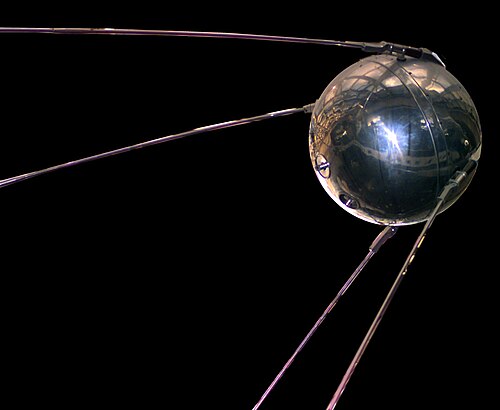Sputnik 1
Sputnik 1 was the first artificial satellite to go around the Earth.[2][3] It was made by the Soviet Union.[2] It was launched on 4 October 1957 at Baikonur Cosmodrome.[2] It orbited (went around) the Earth for three months.[2] It carried a radio transmitter. It did 1,440 orbits of the Earth during this time. It went down into Earth's atmosphere on 4 January 1958 and burned up.[2]
 Replica of Sputnik 1 | |
| Names | Спутник-1 |
|---|---|
| Mission type | Technology demonstration |
| Operator | OKB-1 |
| Harvard designation | 1957 Alpha 2 |
| COSPAR ID | 1957-001B |
| SATCAT no. | 00002 |
| Mission duration | 21 days |
| Orbits completed | 1440 |
| Spacecraft properties | |
| Manufacturer | OKB-1 Ministry of Radiotechnical Industry |
| Launch mass | 83.6 kg (184 lb) |
| Dimensions | 58 cm (23 in) diameter |
| Power | 1 watt |
| Start of mission | |
| Launch date | 4 October 1957, 19:28:34 UTC |
| Rocket | Sputnik 8K71PS[1] |
| Launch site | Baikonur 1/5[1] |
| End of mission | |
| Disposal | Orbital decay |
| Last contact | 26 October 1957 |
| Decay date | 4 January 1958[1] |
| Orbital parameters | |
| Reference system | Geocentric |
| Regime | Low Earth |
| Semi-major axis | 6,955 km (4,322 mi) |
| Eccentricity | 0.05201 |
| Perigee | 215 km (134 mi) |
| Apogee | 939 km (583 mi) |
| Inclination | 65.1° |
| Period | 96.2 minutes |
| Epoch | 4 October 1957, 15:12 UTC |
| Instruments | |
| Radio transmitter (20.005 MHz - 40.002 MHz) | |
The United States was very surprised when the Soviet Union sent Sputnik 1 into space. It did not want to fall behind. So, it began spending more money on science and education.[4] This was when the Space Race between the Soviet Union and the United States began. The competition helped the US and Russia fuel the United States’ space exploration endeavors.
Etymology
The word Sputnik comes from the Russian Спутник, literally traveling companion. It is pronounced IPA: ['sput.nik] or IPA: ['sput.nık], not 'spʌt.nık.[2][5]
Sputnik 1 Media
Last remaining piece of Sputnik 1: metal arming key which prevented contact between batteries and transmitter prior to launch; on display at the Smithsonian National Air and Space Museum
One of the first reports of Sputnik 1 by Universal Newsreel on 7 October 1957. Note that the launch vehicle is depicted incorrectly, owing to lack of knowledge released to the public.
Sputnik 1's steady beep, which "both thrilled and terrified" listeners
"BEEP ... BEEP ... To Bob's" spaceship ad spoofs Sputnik in the California Institute of Technology yearbook of 1958
Sputnik 1, Sergei Korolev and Valentin Glushko on a 2007 Ukrainian stamp
Related pages
References
- ↑ 1.0 1.1 1.2 Wade, Mark. "Sputnik 1". Encyclopedia Astronautica. Archived from the original on 27 December 2016. Retrieved 8 January 2017.
- ↑ 2.0 2.1 2.2 2.3 2.4 2.5 "Sputnik 1". NASA NSSDC. Archived from the original on 2011-10-19. Retrieved 2011-12-24.
- ↑ Latifiyan, Pouya; Mazlumi, Farhad; HabibNejad, Saeed (2024). "1". Satellite Internet in the Aviation Industry. Aviation Electronics and Telecommunications Engineering Department (1st ed.). Tehran, Iran: Civil Aviation Technology College. doi:10.13140/RG.2.2.25125.92640.
- ↑ Calmes, Jackie (2010-12-06). "Obama Calls for New 'Sputnik Moment'". The New York Times. Retrieved 2011-12-24.
- ↑ Siddiqi, Asif A. (2003). Sputnik and the Soviet Space Challenge. Universityy of Florida Press. p. 155. ISBN 0-8130-2627-X.







